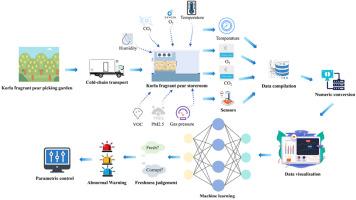多传感器融合优化机器学习的库尔勒香梨无损保鲜监测
IF 6.3
1区 农林科学
Q1 FOOD SCIENCE & TECHNOLOGY
引用次数: 0
摘要
传统的库尔勒香梨新鲜度评价方法存在效率低、成本高、依赖主观评价或破坏性评价等缺点。本研究提出了一种非破坏性的多传感器融合方法,该方法集成了气体成分(O2, CO2, VOC),环境参数(温度,湿度,PM2.5,压力)和介电性能(C, D, ε)。使用机器学习模型(BPNN、SVM、RF)对数据进行分析,并通过遗传算法(GA)和粒子群优化(PSO)进行优化。还制定了基于介质的分级标准(L1-L4)。介电参数与关键新鲜度指标密切相关(牢固性r = 0.86, SSC r = 0.88)。基于高斯核的PSO-SVM模型准确率为97.50%,f1得分为97.49%,偏差为0.54%。多源融合明显优于单传感器模型,仅气体数据的精度较低(47.12%±2.35%)。基于。net的监测平台的数据采集准确率为97.74%。这些发现强调了一种低成本的实时新鲜度监测解决方案,与传统方法相比有了实质性的改进,并支持水果储存中的智能质量控制。本文章由计算机程序翻译,如有差异,请以英文原文为准。

Multi-sensor fusion with optimized machine learning for non-destructive freshness monitoring of stored Korla fragrant pears
Traditional freshness assessment methods for Korla fragrant pears are limited by inefficiency, high cost, and reliance on subjective or destructive evaluations. This study proposes a non-destructive, multi-sensor fusion approach that integrates gas composition (O2, CO2, VOC), environmental parameters (temperature, humidity, PM2.5, pressure), and dielectric properties (C, D, ε). Data were analyzed using machine learning models (BPNN, SVM, RF), optimized via genetic algorithms (GA) and particle swarm optimization (PSO). A dielectric-based grading standard (L1–L4) was also developed. Dielectric parameters correlated strongly with key freshness indicators (r = 0.86 for firmness; r = 0.88 for SSC). The PSO-SVM model with a gaussian kernel achieved 97.50 % accuracy and a 97.49 % F1-score, with 0.54 % deviation. Multi-source fusion significantly outperformed single-sensor models, as shown by the low accuracy (47.12 % ± 2.35 %) of gas-only data. A NET-based monitoring platform demonstrated 97.74 % data acquisition accuracy. These findings highlight a low-cost solution for real-time freshness monitoring, offering substantial improvements over traditional methods and supporting intelligent quality control in fruit storage.
求助全文
通过发布文献求助,成功后即可免费获取论文全文。
去求助
来源期刊

Food Control
工程技术-食品科技
CiteScore
12.20
自引率
6.70%
发文量
758
审稿时长
33 days
期刊介绍:
Food Control is an international journal that provides essential information for those involved in food safety and process control.
Food Control covers the below areas that relate to food process control or to food safety of human foods:
• Microbial food safety and antimicrobial systems
• Mycotoxins
• Hazard analysis, HACCP and food safety objectives
• Risk assessment, including microbial and chemical hazards
• Quality assurance
• Good manufacturing practices
• Food process systems design and control
• Food Packaging technology and materials in contact with foods
• Rapid methods of analysis and detection, including sensor technology
• Codes of practice, legislation and international harmonization
• Consumer issues
• Education, training and research needs.
The scope of Food Control is comprehensive and includes original research papers, authoritative reviews, short communications, comment articles that report on new developments in food control, and position papers.
 求助内容:
求助内容: 应助结果提醒方式:
应助结果提醒方式:


